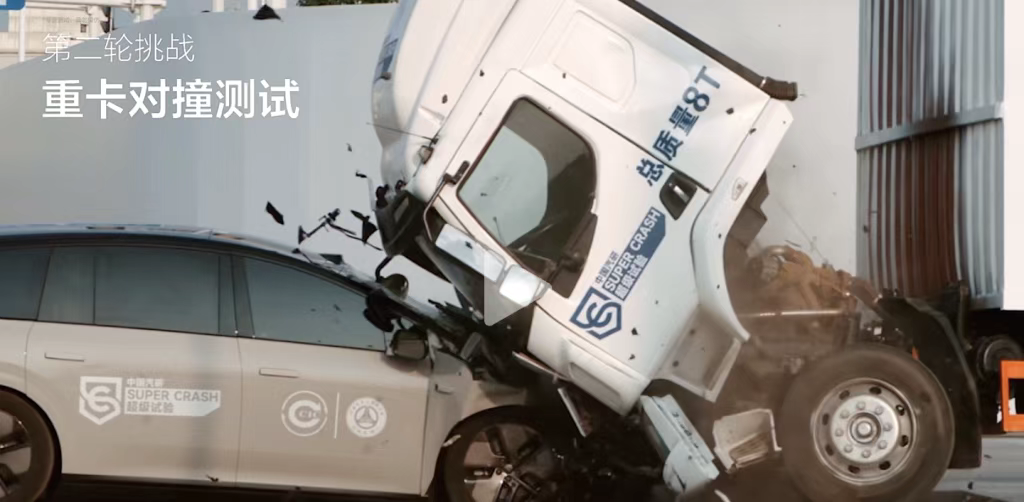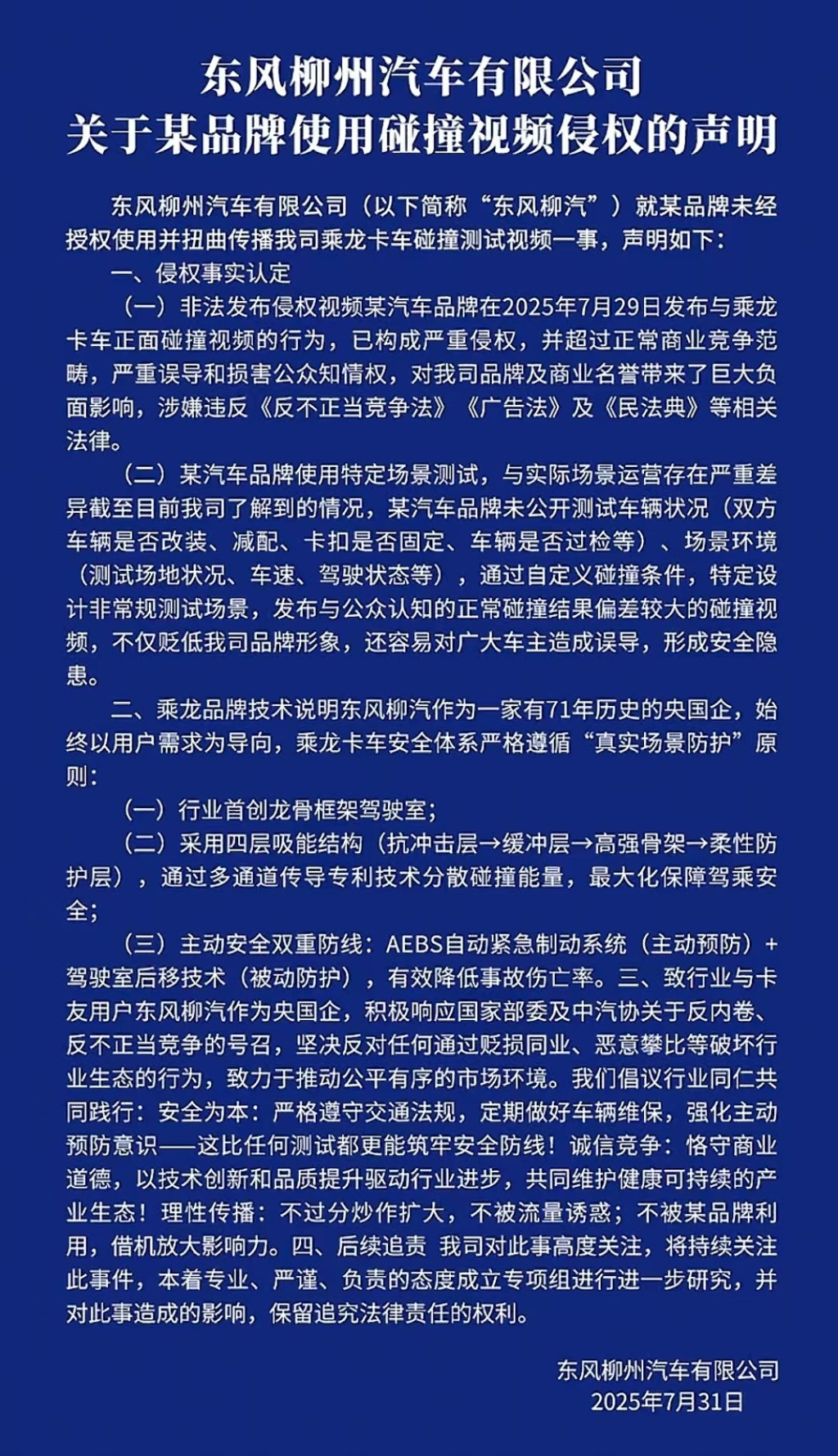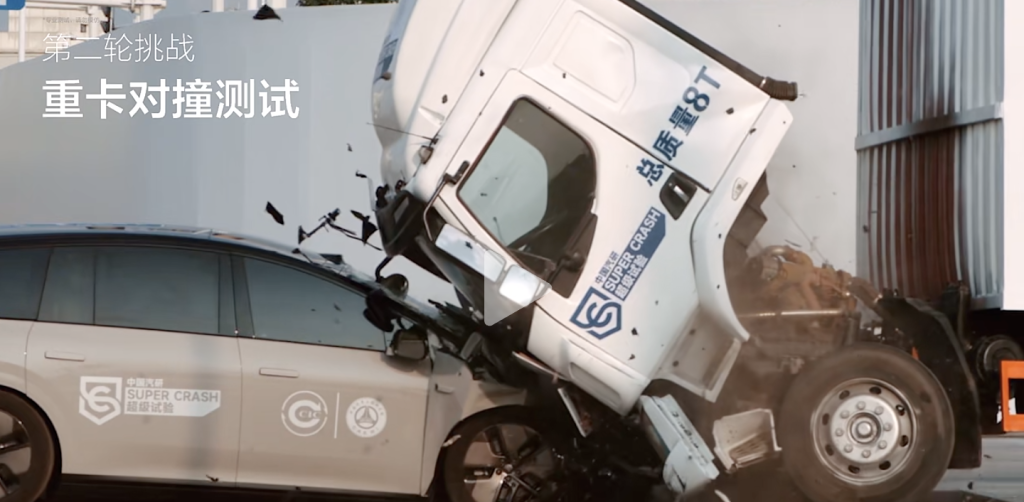
The issue of "Ideal's new car was tested with a Chenglong truck and then flown into space" has sparked heated public debate in recent days. All three parties involved have responded to the matter.
Ideal Auto said that the super experiment of the Ideal i8 colliding with a truck was based on a simulation of users' real traffic scenes, and was fully entrusted to a professional third-party testing agency for testing and certification. The test site, test equipment, and test trucks randomly purchased from the market were all provided by the testing agency.
As the testing organization, China Automotive Research Institute, its securities department staff responded that the entire testing process must comply with all regulations and standards, and will not deliberately adjust vehicle parameters just because (which party) is the customer.
Dongfeng Liuzhou Motor Co., Ltd., the manufacturer of Chenglong trucks, issued a public statement saying that a certain brand's collision video "constitutes serious infringement, exceeds the scope of normal commercial competition, seriously misleads and damages the public's right to know, and has a huge negative impact on our company's brand and business reputation." It also said that it is suspected of violating the Anti-Unfair Competition Law, the Advertising Law and other laws.

Crash test video released by Ideal Auto.
How to test car safety collision test
Crash testing is one of the most important ways to assess vehicle safety performance. It assesses the structural safety of a vehicle and its ability to protect occupants, typically through frontal and side impacts. It provides valuable insights for consumers and drives automakers to continuously improve vehicle safety designs. For example, key safety design optimizations are often conducted after crash testing.
However, it's important to note that standardized global crash tests typically don't pit cars against each other directly, but rather against walls or moving barriers. This can be seen in some common crash test videos. This approach is primarily due to cost considerations; secondly, and more importantly, the stability of test conditions in a vehicle-to-vehicle collision scenario can easily deviate, affecting the comparability of results.
Therefore, the "car hitting truck" video released by Ideal this time leaves room for discussion in terms of professionalism and rigor compared to standardized automobile safety collision tests.
Meanwhile, while the "crossover" test of a passenger car colliding with a commercial truck might seem to exaggerate the contrast, its actual reference value is questionable. Trucks and passenger cars differ significantly in safety goals, structural design, and testing standards. As one netizen pointed out, an unladen truck has a high center of gravity, so a rollover or cabin deformation doesn't necessarily indicate a stronger opponent.
The incident sparked controversy because, despite the significant weight and size disparity, the Ideal i8 managed to "fly" a large truck, seemingly defying common physics and even challenging public perception. Even setting this aside, as Dongfeng Liuzhou Motor pointed out in its response, the lack of public disclosure of key information, such as the test vehicle condition (whether either vehicle was modified or had features removed, whether the clips were secure, whether the vehicles had passed inspection, etc.) and the test environment (test site conditions, vehicle speed, driving status, etc.), raises questions about the fairness of this collision test.
Car crash tests are more than a simple "two-car collision" to determine the winner. Their core objective is to scientifically evaluate a vehicle's ability to protect occupants in specific accident scenarios through standardized, repeatable, and comparable experimental environments. However, this test, at least based on the disclosure of some key information, may not be in line with this objective. Consequently, many netizens suspect it's a "show" for marketing purposes.
Is it "pulling down" or "unintentional harm"?
Another controversial point in the incident is that the initial collision video released by Ideal revealed the truck's brand logo, raising suspicions of fraud and discrediting a competitor. While many believe passenger cars and trucks aren't direct competitors, the public outcry over the "truck being unable to hit a passenger car" incident inevitably led to unwanted negative consequences for the truck brand.
From this perspective, even if the test results are true and not falsified, and even if exposing the other party's brand is "inadvertent harm", it probably leaves an impression of being unkind and unprofessional.
It's worth noting that similar tests—including direct comparisons with competitors, or even deliberate disparagement of rivals to elevate one's own marketing—are not uncommon in the fiercely competitive automotive marketing wars of recent years. The strong public reaction to this incident may be related to the long-standing public backlash against this type of marketing tactic.
Whether the results of this "dramatic" collision test are distorted, what their actual reference value is, and whether the act of revealing the other party's logo constitutes infringement, can only be determined after the relevant parties provide more explanations and third-party professional organizations and judicial institutions make fair judgments. However, the controversy stirred up by this incident at least provides two warnings:
First, automotive marketing should have boundaries. Crash testing, a professional process crucial to vehicle safety and the public's right to know, should not be reduced to a marketing tool for automakers. If safety performance testing is reduced to a "win-lose" marketing gimmick, it will ultimately damage the reputation of automakers and the trust of consumers. Furthermore, even in the most intense competition, the legitimate rights and interests of competitors should be respected, and safety publicity should serve the purpose of public education, not disparaging competitors.
Second, the automotive testing market needs to be more standardized. Recently, a certain app's intelligent driving tests have sparked considerable controversy within the industry. This serves as a reminder that with the rise of new energy vehicles and intelligent driving, regulations in the automotive testing market must also evolve with the times. Institutional credibility, testing standards, and transparency should all better meet society's growing demands for safety and the healthy development of the automotive industry.

